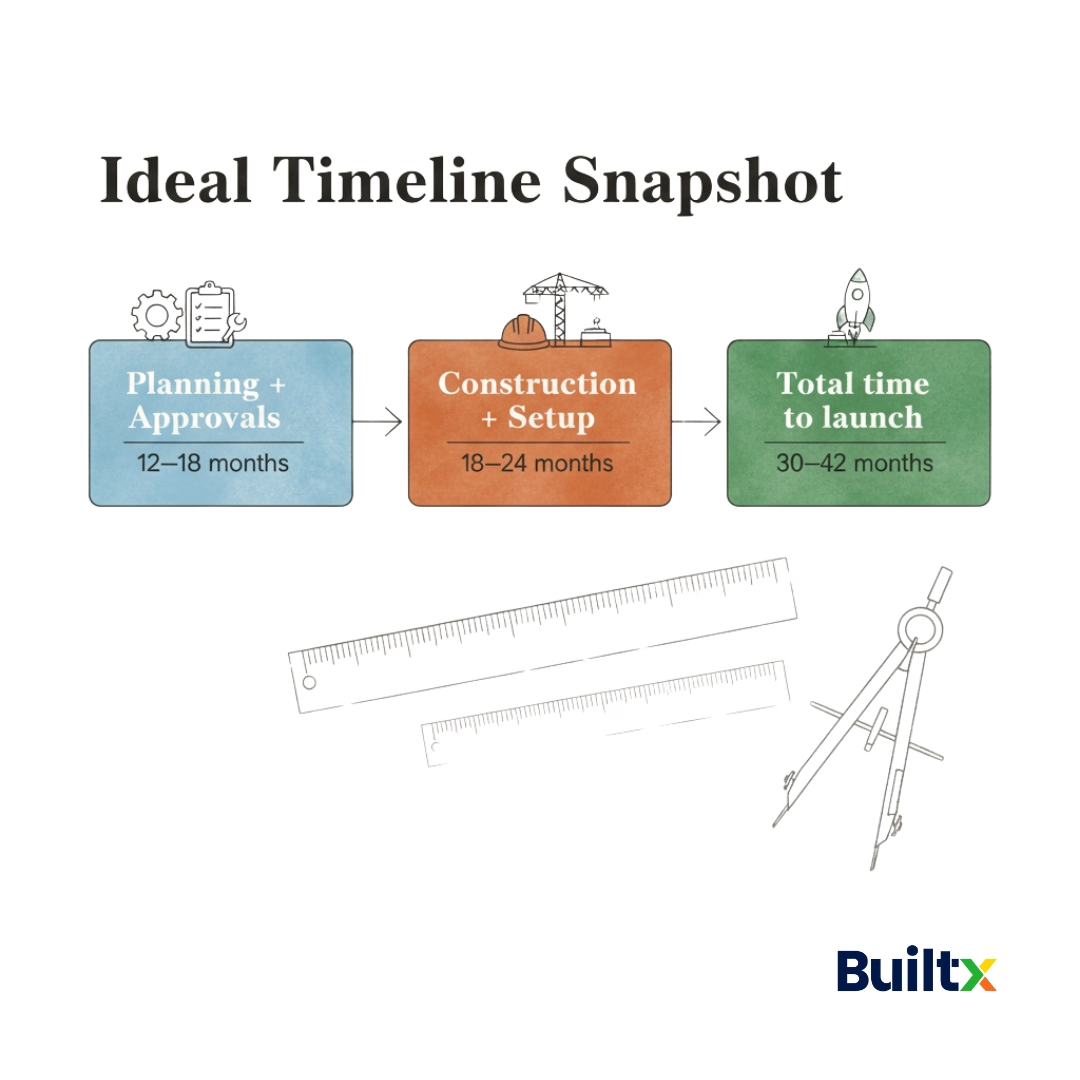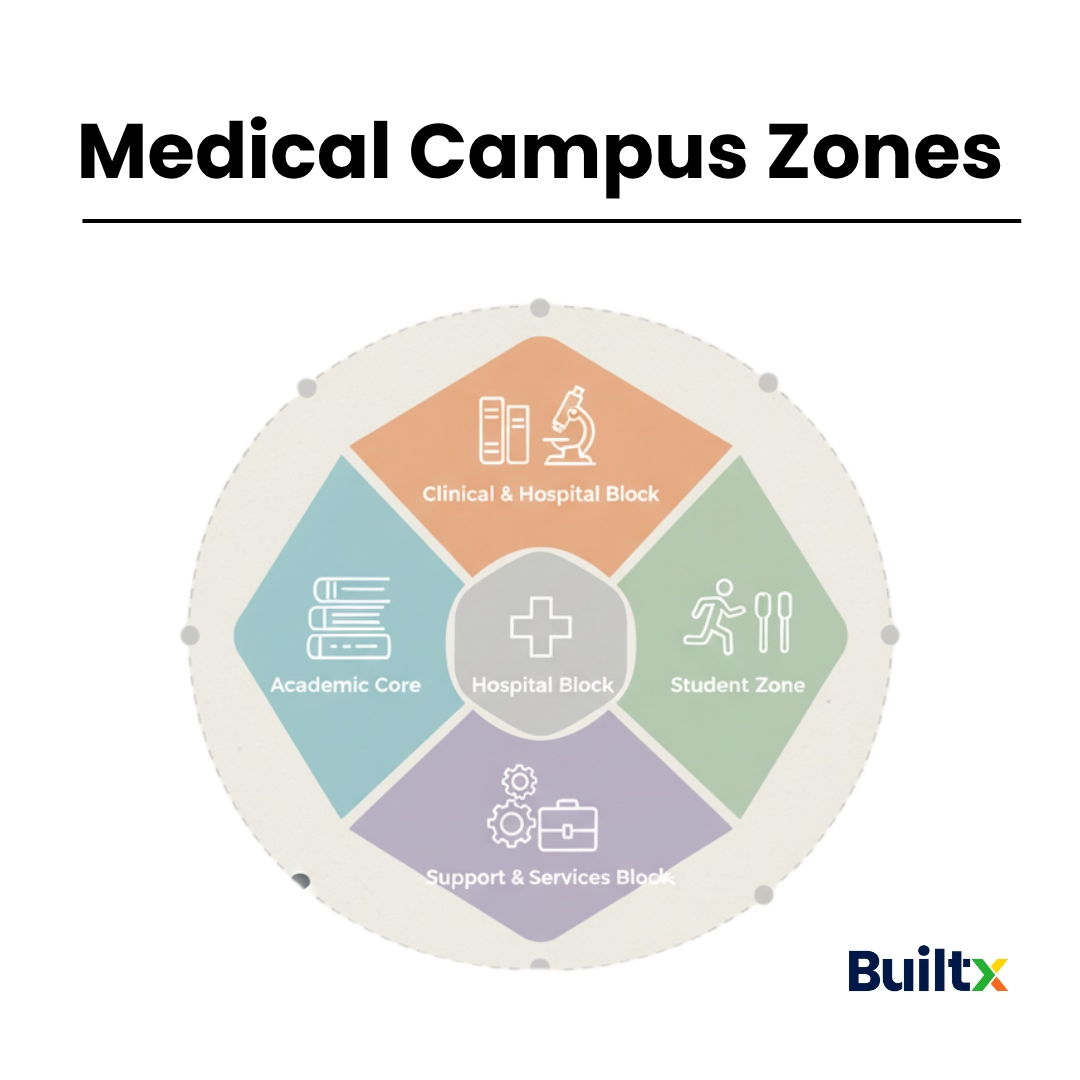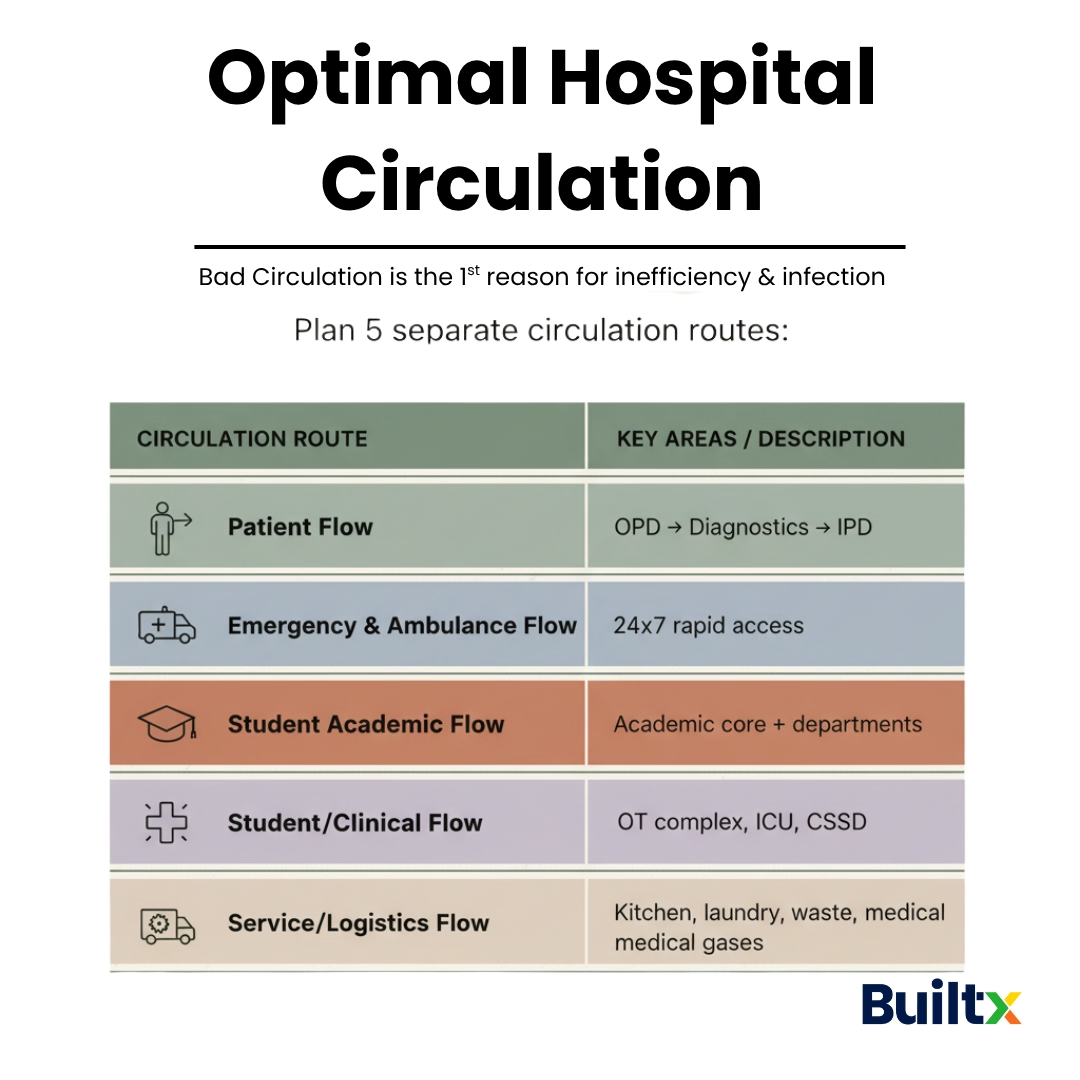How to Plan a Medical College Campus in India (2025 Guide) – Planning, Design & Zoning
.avif)
Table of content
Plan a medical college campus in India (2025) with a clear strategy, regulatory alignment, and sustainable vision. India’s healthcare landscape is expanding rapidly, yet the country still faces a critical gap of qualified doctors. As of 2024, there is one doctor for every ~834 people, according to the Press Information Bureau (PIB), an improvement from a decade ago but still below the World Health Organization’s (WHO) ideal ratio of 1:600.
With healthcare demand rising, the Ministry of Health and Family Welfare (MoHFW) has approved 157+ new medical colleges since 2020 under centrally sponsored schemes (PIB, 2024). This surge has encouraged more promoters, universities, healthcare groups, and trusts to start medical college campuses—often for the first time.
Quick Fact: Over 80% of Letter of Permission (LoP) rejections occur due to hospital non-readiness or weak academic–clinical integration (MoHFW, 2023).
Under the latest NMC Gazette (2023–24), every new institution must demonstrate a fully functional teaching hospital before receiving LoP approval, making master planning the single most critical stage before construction begins.
To make the process easier, this comprehensive 2025 guide is divided into two parts:
- Part 1: Planning, Design & Zoning, covering land strategy, campus master plan, and hospital–academic integration.
- Part 2: Cost, Approvals & NMC Compliance, detailing financial planning, regulatory pathways, and compliance checklists.
Together, they provide a step-by-step, data-backed roadmap to plan an NMC-ready Medical College Campus + Teaching Hospital that is sustainable, future-ready, and financially viable from day one.
Note: BuiltX is a construction company that build infrastructure for non profit organization. Whether its a school, hospital or college
Checkout the Hospital Construction Cost in Indian in 2026
This roadmap will help promoters plan strategically across academics, hospital, compliance, and financial phases.
Step 1: Define the Vision & Academic–Clinical Model (Month 0–1)
- Clarify what kind of medical college you intend to create, public-charitable, private-university, or an expansion of an existing hospital along with its long-term academic scope.
- Start with the MBBS program and plan how allied and postgraduate courses can be added in later phases.
Step 2: Conduct Feasibility & DPR (Month 1–3)
A strong Detailed Project Report (DPR) strengthens LoP approval, bank funding, and project credibility.
DPR includes:
- Demand & catchment analysis
- Land suitability & access study
- 10-year student intake plan
- Hospital service mix & bed-phasing
- CAPEX + OPEX + revenue models
- Risk mitigation plan
Tip: A DPR with a 10-year vision + 5-phase execution scores higher with NMC & lenders.
Step 3: Acquire Land & Finalise Master Plan Strategy (Month 2–5)
Select land only after feasibility. (Details in Section 3 below)
Step 4: Freeze Master Plan & Zoning (Month 4–6)
This is the most critical stage where architects, hospital planners, and medical educators must collaborate.
- Academic + hospital integration
- Circulation planning (students, patients, emergency, services)
- Future expansion blocks reserved
- Campus life ecosystem (hostels, residences, sports, student amenities)
At BuiltX, we often find that early collaboration between architects, hospital planners, and medical educators prevents redesign costs later in the NMC approval cycle. Our team’s integrated design-build approach keeps both academic and hospital zones aligned from Day 1.
Step 5: Apply for State Government Essentiality Certificate (EC) (Month 6–9)
Required before NMC application.
Step 6: Develop Detailed Designs + Pre-Construction (Month 6–12)
- Architectural + structural + MEP + medical planning
- Procurement strategy
- Contractor selection
How to build a heart hospital in 2026
Step 7: Construction & Hospital Commissioning (Month 12–32)
For a compliant hospital + academic block ready for inspection:
- Teaching hospital operational with required beds & departments
- Academic block with pre-clinical departments
- Faculty recruitment starts
Step 8: Apply for NMC Letter of Permission (LoP) (Month 24–30)
Discuss in part 2
Step 9: Student Admissions & Year-Wise Expansion (Year 1–5)
Discuss in part 2

How to get hospital license in India
Campus planning must start with the right land parcel and master plan philosophy because this single decision influences:
- NMC approval success
- Future expansion feasibility
- Emergency access + patient footfall
- Residential & campus life quality
Minimum Land Requirement (2026)
Some States permit land relaxation to 10 acres in metropolitan cities subject to strict justifications and vertical campus planning.
Urban vs Semi-Urban vs Rural Land Strategy
Important: A medical college must show sustained OPD/IPD patient load for NMC inspections. So, patient catchment > cheap land.
Master Plan Must Cover 5 Zones
A high-performing medical campus needs five distinct but interconnected zones:
- Academic Core – lecture halls, labs, library, pre-/para-clinical departments
- Clinical & Hospital Block – OPD, IPD, emergency, diagnostics, OTs
- Student Zone – hostels, dining, sports, student amenities
- Faculty & Staff Housing – residences, guest house, recreation
- Support & Services Block – utilities, laundry, CSSD, mortuary, logistics entries
Reserving 25–30% of land for future expansion is recommended.

Campus Planning Principles for Medical Colleges
- Academic & hospital circulation must not overlap
- Emergency & ambulance access independent
- Infection control zoning integrated into master plan
- Hospital revenue sustainability considered from day one
How to build a patient centric hospital in 2026
Quick Snapshot: Built-Up Area Norms (Indicative)
Sustainability & Long-Term OPEX Planning Starts Here
A poorly designed campus will cost ₹12–₹22 crore more per year in OPEX after Year 3.
Plan early for:
- Energy-efficient design (ECBC compliance)
- Solar & STP reuse
- Medical gas & hospital OPEX optimisation
- Digital healthcare integration infrastructure
Medical college campus planning is a specialised exercise requiring an integrated approach across academics + medical planning + hospital operations + student life.
A well-zoned campus ensures:
- Smooth student–patient–faculty movement
- Infection control & sterile circulation
- Hospital revenue optimisation
- Positive campus experience for 1,500–3,500 residents
Key Principle
Do not design it like a general hospital or a typical university. A medical college is an academic–clinical ecosystem.
The Ideal Medical Campus Zoning Model
A recommended zoning distribution:
Student and patient circulation paths must never intersect.
Circulation & Flow Planning (Non-Negotiable)

Infection Control by Design
- Separate clean vs soiled corridors
- Negative pressure rooms & isolation wards
- OT sterile–semi sterile–non-sterile zoning
- HVAC zoning & pressure differentials
Hospitals that skip this during planning spend ₹4–₹6 crore later on redesign and infection-control retrofits.
Sustainability to Cut OPEX (Target: 20–28% Savings)
Energy & water form 45–55% of hospital OPEX. Use:
- ECBC-compliant architecture
- Solar PV for 20–30% load
- STP + treated water reuse
- Sensor-based lighting & HVAC controls
- Heat recovery systems
A sustainable design reduces ₹8–₹15 crore OPEX annually after Year 3.
BuiltX integrates ECBC-compliant architecture, smart-energy systems, and long-life materials into its medical campus designs — helping institutions lower OPEX by up to 25 % without compromising NMC standards.
Key Master Plan KPIs for Promoters
Hospital Floor Plan Guide 2026
Hospital quality determines NMC approval success, Talent attraction (faculty, residents, PG courses), Patient trust and hospital revenue, Clinical exposure for students
(Internal Link Placeholder: Insert link to “Hospital Planning Standards in India” here)
Bed & Department Requirement (NMC)
Hospital Departments & Clinical Labs Must Align with Academics
Simulation & Skills Training (Modern Requirement)
NMC is pushing for competency-based medical education (CBME).
A state-of-the-art Skills & Simulation Centre should include:
- High-fidelity mannequins
- Emergency response simulation
- OT & ICU simulation modules
- Virtual anatomy tools
- Tele-medicine practice rooms
This boosts institute ranking and PG program approval chances.
Academic–Clinical Integration Model (Recommended)
BuiltX provides services to healthcare trusts and universities in developing teaching hospitals that meet NMC benchmarks. If you are planning for one, contact us today!
Medical education is evolving beyond textbooks and cadavers. To attract top faculty and future-proof learning, campuses must move towards NEP 2020 aligned, tech-enabled, interdisciplinary learning.
Academic Block Must Include (Minimum)
- Lecture theatres (ICT-enabled)
- Departmental museums
- Laboratories (Pre & Para Clinical)
- Library + Digital e-library
- Examination hall
- Seminar rooms
- Common rooms for boys and girls
Future-Ready Learning Upgrades
Student Experience = Long-Term Reputation
A medical campus becomes home for 1,200–3,500 students, residents & staff.
Student retention depends on:
- Hostels with hygiene & safety
- Sports & recreation
- 24/7 reading rooms & cafeterias
- Mental health support cell
Poor hostels = terrible Google reviews = brand damage.
Top 10 Hospital Design Requirement in 2026
Planning a medical college campus is far more than a regulatory checklist, it’s the foundation for decades of medical education, healthcare service, and community impact.
A well-planned campus aligns academic and clinical ecosystems, ensures smooth hospital operations, and reduces redesign or OPEX losses later. When institutions treat master planning as a long-term investment, they unlock stronger faculty retention, faster NMC approvals, and sustained patient trust.
At BuiltX, we help trusts, universities, and healthcare promoters translate this vision into reality, integrating design, engineering, and operations from the first sketch. Our approach ensures that every campus we plan is sustainable, efficient, and ready for NMC evaluation from day one.
This article covered the planning, design, and zoning framework that forms the backbone of an NMC-ready medical college.
Coming next: Part B – Cost, Approvals & NMC Compliance (to be published soon), a continuation of this guide detailing budgeting models, LoP/LoI pathways, and regulatory best practices for promoters preparing to launch new medical colleges in India.

